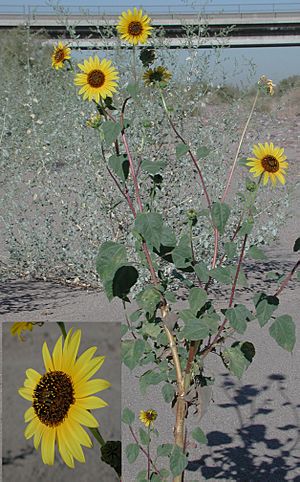Western sunflower facts for kids
Quick facts for kids Western sunflower |
|
|---|---|
 |
|
| Conservation status | |
| Scientific classification | |
| Genus: |
Helianthus
|
| Species: |
anomalus
|
The western sunflower, also known as Helianthus anomalus, is a special type of plant. It belongs to the sunflower family and grows in the southwestern United States.
This sunflower is very interesting to scientists because of how it was created. It's a natural mix, or hybrid, of two other sunflower species: the common sunflower (H. annuus) and H. petiolaris. This mixing happened many times, between 60,000 and 200,000 years ago! From these two parent plants, three different types of hybrid sunflowers formed. Each type has its own unique features and preferred places to live.
Contents
Where Western Sunflowers Grow
The western sunflower, Helianthus anomalus, is found in the United States. You can see it in Arizona, New Mexico, Nevada, and Utah. It's a native plant, meaning it has always grown in these areas. It wasn't brought there from somewhere else.
Both types of H. anomalus hybrids live in tough places. They grow in sand dunes, which are sandy hills. These areas don't have much nitrogen or water, making them very challenging for plants.
How Western Sunflowers Survive
Helianthus anomalus has amazing features that help it live in its harsh sand dune home. Its leaves are very "succulent," meaning they are thick and can store a lot of water. This helps the plant survive long dry periods, which are common in deserts. The spongy parts of the leaves hold the water.
This sunflower also has large seeds and roots that grow very quickly. These traits help it survive in extreme environments. Scientists believe that large seeds are good for dune plants. They help prevent the seeds from being buried too deep by shifting sand. Helianthus anomalus is an annual plant, which means it lives for only one growing season. Sadly, it is considered a vulnerable species, and its numbers are decreasing.
What Western Sunflowers Look Like
You can spot Helianthus anomalus by its bright yellow flowers. Its leaves are oval-shaped and grow in an alternating pattern along the stem. The plant produces fruits called achenes, which are like small, dry seeds.
A study in 2001 looked at many sunflower species. It found that H. anomalus plants are usually about 1.2 meters (about 4 feet) tall. Their leaves are typically 9.69 centimeters (about 3.8 inches) long. Their roots grow to an average length of 6.45 centimeters (about 2.5 inches). This deep root growth is important for their dry environment. It helps them find water deep in the soil. The large size of their achenes (fruits) helps these roots grow strong and long.
How Western Sunflowers Were Created
Biologists are very interested in Helianthus anomalus because it's a natural hybrid. This means it formed in nature when two other sunflower species mixed their genes. The parent plants are the common sunflower (H. annuus) and H. petiolaris.
These two parent sunflowers grow in very different places. H. annuus prefers clay-based soils, while H. petiolaris likes sandy soils. But the hybrid H. anomalus can live in a completely different and tough environment, like sand dunes! This is because of how the genes from the parent plants combine and become dominant in the hybrid. Experiments show that each parent and the hybrid prefer their own specific habitats.
Future Uses of Western Sunflowers
Scientists are looking at Helianthus anomalus as a possible source for alternative fuel. Finding new fuel sources has been a big challenge for many years. Sunflower oil is one idea for a new fuel.
There are 51 different species in the Helianthus group (sunflowers). Among them, H. anomalus shows a lot of promise. It has a high amount of oil, a good concentration of linoleic fatty acid, and large achenes (fruits). These qualities make it a good candidate for producing fuel.


